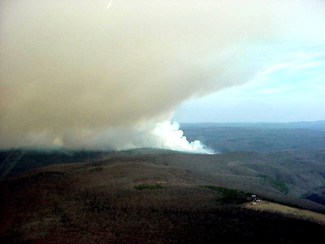Some of you may remember that we sheltered evacuees of the human and feline persuasion at our house during the North Fork Fire. Of course, during that period I overheard conversations all the time (at the hair salon, library) about “what they should have done” from folks who have never dealt with fire, prescribed or suppression.
When I first heard of this fire, my first response was “there, but for the grace of Gaia, go we.”
Here’s an op-ed today from the Denver Post with the views of some residents.
Now, a review was done by some FS folks that found no fault by the State. As a Colorado taxpayer, I am having some trouble with the homeowners’ quest to get into my pockets in the name of “justice.” I’m also concerned that this could happen with future (perceived, disputed and litigated?) “errors” in suppression.. leading to liabilities, one way or the other, that states can ill afford in this economic climate.
How can we live in a fire-adapted landscape, protect people and communities, and have the appropriate people (whoever they are) take the risks, do the dangerous work, and pay the bills?
Guest Commentary: What is the state’s responsibility in the Lower North Fork fire?
By Scott Appel and Tom Scanlan
Two months ago, a wildfire set by the Colorado State Forest Service burned 23 homes to the ground and tragically killed three of our loved ones, friends and neighbors. A so-called “controlled burn” quickly flared out of control, and within hours on a Monday afternoon, destroyed everything our families built up over a lifetime.
The physical decimation of our personal items and property pales in comparison to the loss of the lives of Ann Appel and Sam and Linda Lucas to their families and our community. Their deaths and the fire’s total devastation is horrific — and was completely avoidable. As residents of the now-ashen Kuehster Road community, we are grateful that Gov. John Hickenlooper and the state legislature acted to amend the Colorado Governmental Immunity Act to include a waiver for prescribed burns, which was signed Monday. This is a common-sense amendment and a step toward justice, not only for the victims of the Lower North Fork fire but also for all Colorado citizens who may in the future be similarly impacted.
However, the signing of this bill is only a preliminary action toward the state taking full responsibility for the devastation it has wreaked. This legislation is imperfect because it promises nothing more than an “avenue to seek compensation,” lacking any assurances that we will be compensated for our losses not covered by insurance. The legislation says only what the state can do, but does not say what the state will do.
We know exactly how this tragedy was brought upon us, yet we are faced with the feeling that the burden of proof is on us, having to endure a complex governmental review process before recommendations are made for restitution. The amendment makes no promises for the time frame of this process, or that any reasonable compensation will be awarded to victims. In the meantime, our bills and obligations continue.
We have spent the last two months sifting through ashes, testifying before the state legislature, working with our elected representatives to get the state to take responsibility for its actions. Serious questions remain surrounding why this fire was set under dangerously dry conditions when weather reports predicted high winds; why the state ignored its own protocols by leaving the burn unattended; why an evacuation wasn’t ordered earlier when it was already known the fire was out of control; and why the reverse 911 call system failed to warn people in harm’s way.
Moreover, the state’s own review of the fire failed to consult any of the families that lost their homes or numerous witnesses of the fire.
The Kuehster Road community is made up of responsible citizens who pay our taxes and look out for ourselves and our neighbors. We practice fire mitigation through state-recommended guidance to minimize the possibility of forest fires. It’s a far cry from justice when the state Forest Service runs away from taking responsibility for its actions.
We have never asked the state of Colorado for anything. We are not asking for a handout now, but we shouldn’t have to continue to fight for justice as we try to rebuild our lives from this tragedy. Coloradans understand fairness, and what it means to correct a horrible injustice. We sincerely appreciate the outpouring of sympathy from our fellow citizens, who instinctively know how wrong this was.
We are grateful to the governor and our other elected leaders for putting forth this legislation. The governor has personally promised us that this process would not get bogged down in a partisan politics, and we hope and trust that he can prevent it.
We call upon all our elected officials and state agencies to ensure that with the signing of this legislation, they too are fully committed to a quick and just resolution of this tragedy. We ask the state to act as expeditiously and fairly as the state insurance commission would require of any private party who had caused similar harm.
Scott Appel is the husband of Ann Appel, who died in the Lower North Fork Fire. Tom Scanlan is retired from the U.S. Air Force. They wrote this piece on behalf of the residents of the Kuehster Road community.
Note from Sharon: I personally know and respect the team leader of the FS review team. In all these high emotions and complex conditions of nature and humans, I don’t believe that we have anything else to fall back on but the personal integrity of experienced individuals.






 Americans continue to struggle with the idea of a public good, a “
Americans continue to struggle with the idea of a public good, a “
